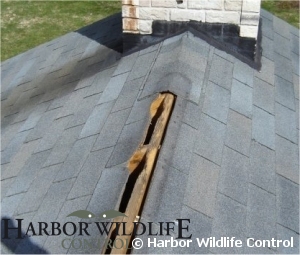Gray Squirrel
throughout New Jersey and Staten Island, NY
 Gray Squirrel |
The Eastern Gray Squirrel (Sciurus carolinensis), or the Grey Squirrel, depending on region, is a tree squirrel native to the eastern and midwestern United States and to the southerly portions of the eastern provinces of Canada. As the name suggests, the Eastern Gray Squirrel has predominantly gray fur but it can have a reddish color. It has a white underside and a large bushy tail.
Particularly in urban situations where the risk of predation is reduced, both white- and black-colored individuals are quite often found. The melanistic form, which is almost entirely black, is predominant in certain populations and in certain geographic areas, such as in large parts of southeastern Canada. There are also genetic variations within these, including individuals with black tails and black colored squirrels with white tails. The head and body length is from 9 to 12 inches, the tail from 7 to 10 inches and the adult weight varies between 1 and 1.5 pounds.
 Gray Squirrel Tracks & Scat |
 Eastern Gray Squirrel Damage |
Eastern Gray Squirrels breed twice a year, December to February and May to June, though this is slightly delayed in more northern latitudes. The first litter is born in February to March, the second in June to July. There are normally two to six young in each litter, but this number can be as high as 8. The gestation period is about 44 days. The young are weaned at 7 weeks and leave the nest after 10 weeks
Eastern Gray Squirrels can start breeding as early as 5 and a half months old, but usually breed for the first time at a year old. It can live to be 20 years old in captivity, but in the wild it usually only lives to a maximum of 12.5 years old
Damage and Nuisance Situations
They den in attics, walls, sheds, barns, and chimneys, annoying people with their noise and odors. Squirrels usually gain access via overhanging branches, power lines, or by climbing up the siding. They may fall into chimney and furnace flues, thus gaining entrance to the basement or interior of the house. Their nest materials might block a vent, causing a fire hazard.
They chew and scratch wires (another fire hazard) and also damage attic vents, eaves, screens, bird feeders, siding, insulation, household goods, and the tubing used for maple syrup production.
| Middlesex County | Monmouth County | Somerset County | Union County | Warren County |
| Sussex County | Morris County | Essex County | Hudson County | Hunterdon County |
Mercer County and Richmond County (Staten Island), NY